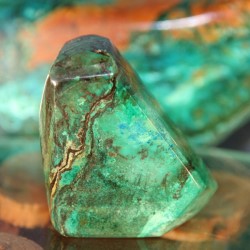From time to time a trade name traditionally used as a quality label is retained, even when the original qualities are no longer available. Often this name is simply transferred to other stones or color varieties that look roughly similar to the original. This is also the case with the so-called »Eilat-Stone«, which appears both on the Internet and on home shopping television.
The classic occurrence of this colorful stone is 25 km north of the city of Eilat, on the southern tip of the State of Israel. In the Timna valley, on the edge of the Negev desert, copper ore was mined over 5000 years ago. The legendary copper mines of King Solomon, from which most of the turquoise used in ancient Egypt originate, are located in the same area.
»Eilat-Stone« is composed of a variety of copper minerals, especially carbonate minerals (malachite, azurite), phosphate minerals (pseudomalachite, turquoise) and silicates (chrysocolla, quartz). Depending on how these components are distributed, blue, blue-green or green colors dominate. These copper mineralizations are formed in a magmatic complex of predominantly granitic composition, which is about 550 million years old. The magmatic activity produced copper-bearing solutions from which copper minerals crystallized, leading to complex mineral aggregations in the oxidation zone.
Since the site was declared a national park, the original »Eilat-Stone« is no longer available. It has been replaced by chrysocolla-malachite from Peru, which is rich in country rocks. Although they also contain the carbonate and silicate minerals of the original »Eilat-Stone«, they lack the phosphate minerals. What sometimes looks like light blue turquoise in the Peruvian stones is chrysocolla, which can be easily checked by its ability to stick to the tongue in its raw, untreated state.
So if you are offered a genuine »Eilat-Stone«, you should pay special attention to the presence of phosphate minerals, which are a good authenticity feature.




